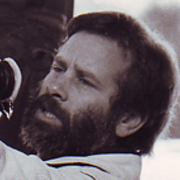
James Bartle
James Bartle's work as a cinematographer has taken him across New Zealand, into the outback of his native Australia, and on to alien planets and Hollywood.
Bartle grew interested in light while growing up in Melbourne. He was fascinated by the way a movie could be seen on the curtains at the cinema, before the curtains opened. Bartle built his own darkroom in a garden shed, and began developing and experimenting with optical equipment.
After studying electrical engineering, his enthusiasm for light won him a job in the lighting department of Channel 9 in Melbourne. Then he moved to the BBC in London and worked on early episodes of the Dr Who series, and classic sitcom Steptoe and Son.
When he returned to Australia, Bartle got a job as chief lighting designer at Sydney's Channel 10. Searching for new challenges, he crossed the Tasman in the mid-70s to set up a television production studio in New Zealand.
Work in commercials introduced Bartle to a number of Kiwi movie directors in the making, including Roger Donaldson, Geoff Murphy and Sam Pillsbury. He was also a cameraman on experimental short Second Sight (1980), centred around two female members of theatrical troupe Red Mole.
In 1982, Sam Pillsbury invited Bartle to shoot small town rite of passage tale The Scarecrow, adapted from the book by Ronald Hugh Morrieson. Bartle brought a striking style to this story of a a murderer arriving in town, mixing moments of gothic horror with golden-hued nostalgia.
Bartle followed The Scarecrow with early Kiwi splatter movie Death Warmed Up (1985), using a wide range of lighting and copious use of a Steadicam camera to bring this tale of mad scientists, madmen and motorcycle chases to the big screen.
His next two projects provided a major contrast. The first was an ambitious tele-film about Iris Wilkinson (aka Robin Hyde), the New Zealand poet, novelist and foreign correspondent. Working with director Tony Isaac and Australian star Helen Morse, Bartle endeavoured to overcome the challenges of working with the "unbelievably bad" video cameras then in use, including using filters to soften the hard edge of the image.
The second production was acclaimed but little-known Bruno Lawrence psychological drama Heart of the Stag, shot largely in the King Country. The Los Angeles Times praised the result as "electifyingly good".
Bartle would win awards and more overseas attention for his next film, apocalyptic science fiction tale The Quiet Earth. Again Lawrence starred, this time with Geoff Murphy directing. The Quiet Earth proved a challenging assignment for Bartle: a wide range of locations, many unusual special effects, plus scenes where cities have to appear emptied of all inhabitants (in the days before widespread use of CG effects).
More fantasy was to come. In 1986 Bartle handled camera duties on two 50 minute dramas: Just Passing Through, directed by Judy Rymer, and Melanie Reid's The Minders, a story of a woman who observes the lives of former friends from the afterlife.
He also began to work overseas, sometimes in Australia but more often in America. A number of the foreign productions brought him back home: for example 1990 cross-cultural comedy Shrimp on the Barbie, which saw him sharing camera duties with future Lord of the Rings cinematographer Andrew Lesnie.
In 1993 Bartle began working on a series of five Hercules tele-movies, beginning with Hercules and the Amazon Women. As director of photography on all five, Bartle made a major contribution to the look and style of the television series which followed.
His work on Hercules led Bartle to develop Picscan, a process which allows film and digital video to be more effectively integrated. Picscan is designed to allow an image stored digitally to retain the maximum possible amount of information from an original film negative.
Bartle went on to work on a long run of mainly American tele-movies, some of them directed by his Scarecrow colleague Sam Pillsbury. Bartle's television CV includes Lucille Ball bio-pic Lucy, shot in Auckland, and an acclaimed 1999 remake of courtroom classic Inherit the Wind which starred Jack Lemmon and George C Scott.
- This profile is adapted from the Duncan Petrie book Shot in New Zealand (Random House, 2007).